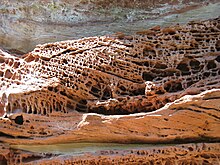Honeycomb weathering: Difference between revisions
Brianwhalley (talk | contribs) →Research: small change and reference added |
Brianwhalley (talk | contribs) |
||
| Line 14: | Line 14: | ||
==Research== |
==Research== |
||
Honeycomb weathering has been studied using [[Scanning Electron Microscope]] (SEM) imaging, laboratory reconstruction of weathering conditions, [[Mass Spectrometry]], [[Electron Diffraction Spectroscopy]] (EDS) and other techniques. It has been studied extensively as it is responsible for the slow destruction of many historical sites worldwide including, the ruined city of [[Petra, Jordan]], and the coping stones of the outer sea wall of [[Weston-super-Mare]], UK |
Honeycomb weathering has been studied using [[Scanning Electron Microscope]] (SEM) imaging, laboratory reconstruction of weathering conditions, [[Mass Spectrometry]], [[Electron Diffraction Spectroscopy]] (EDS) and other techniques. It has been studied extensively as it is responsible for the slow destruction of many historical sites worldwide including, the ruined city of [[Petra, Jordan]], and the coping stones of the outer sea wall of [[Weston-super-Mare]], UK (Mottershead, 1994). An examination of the process and case hardening has recently been given<ref>Bruthans, J., Filippi, M., Slavík, M. and Svobodová, E., 2018. Origin of honeycombs: Testing the hydraulic and case hardening hypotheses. Geomorphology, 303: 68-83.</ref>. |
||
==See also== |
==See also== |
||
Revision as of 13:05, 25 April 2018
This article includes a list of references, related reading, or external links, but its sources remain unclear because it lacks inline citations. (October 2016) |




Honeycomb weathering, also known as fretting, cavernous weathering, alveoli/alveolar weathering, stone lattice, stone lace or miniature tafoni weathering (Mustoe, 1982) is a form of salt weathering common on coastal and semi-arid granites, sandstones and limestones (Mustoe 1982). Honeycomb weathering is not limited to natural settings and can be seen to develop on buildings where a rate of development can be established. This rate can be as fast as several centimeters in 100 years (Mustoe 1982). Honeycomb weathering occurs throughout the world from the polar regions (French and Guglielmin 1999) to the equator. It produces pits in the weathered material, resembling a honeycombed structure. There are two distinct types of coastal honeycomb weathering: intertidal and supratidal.
Cause
For honeycomb weathering to occur, some research indicates that a source of salt is needed because the basic mechanism for this kind of weathering is salt heaving. Salt is deposited on the surface of the rock by saltwater spray or by wind. Moisture must be present to allow for the salt to settle on the rocks so that as the salt solution evaporates the salt begins to crystallize within the pore-spaces of the rock. Permeable rock is also needed so that there are pore-spaces for the salt to crystallize within. These salt crystals pry apart the mineral grains, leaving them vulnerable to other forms of weathering. It takes prolonged periods for this weathering to become visible, as the rock goes through cycles of wetting and drying. However, in some arid and hyper-arid environments (i.e. Southern Jordan), it has been found that the differential weathering that produces tafoni initiation and development may also be linked to freeze-thaw and wetting-drying cycles, in addition to lithologic and micro-climatic variations affecting moisture availability, residency, and source as the primary influence, as compared to salt factors (Paradise 2011).
Intertidal honeycomb weathering is found on horizontal planes in rock within the tidal zone. This type of honeycomb weathering is limited in its growth by the rate of evaporation from the sun. Once the depressions have grown large enough that the sun can not evaporate all of the water left in the gap by the retreating wave, the holes are as large as they will get, because the salt can not dry out and wedge grains apart any longer.
The cause of the characteristic honeycomb pattern in supratidal areas on the vertical plane is still under debate. Some geologists believe that the side walls of the alveoli may be protected from salt weathering by microscopic algae (Mustoe, 1982), while others believe that case-hardening, wind and sun exposure, wetting and drying cycles or mineralogical variations within the stone may be responsible. According to Tom Paradise, one of the prominent researchers on the topic of honeycomb weathering, most likely a combination of these factors produces these delicate structures.
Research
Honeycomb weathering has been studied using Scanning Electron Microscope (SEM) imaging, laboratory reconstruction of weathering conditions, Mass Spectrometry, Electron Diffraction Spectroscopy (EDS) and other techniques. It has been studied extensively as it is responsible for the slow destruction of many historical sites worldwide including, the ruined city of Petra, Jordan, and the coping stones of the outer sea wall of Weston-super-Mare, UK (Mottershead, 1994). An examination of the process and case hardening has recently been given[1].
See also
- Tafoni, a similar weathering feature
References
- French, H.M., Guglielmin, M., 1999, Observations on the Ice-Marginal, Periglacial Geomorphology of Terra Nova Bay, Northern Victoria Land, Antarctica, Permafrost and Periglacial Processes, v.10, p. 331-347.
- Mustoe, G.E., 1982, The Origin of Honeycomb Weathering, Geological Society of America Bulletin, v.93, p. 108-115.
- Paradise, T.R., 2011, Tafoni and Weathered Stone Basins, in Geomorphology (editor G. Pope, J. Shroder), Reed-Elsevier Geosciences Reference Series MORP v.4: 28pp
- Paradise, T.R., 2013, Assessment of Tafoni Distribution and Environmental Factors on a Sandstone Djinn Block above Petra, Jordan, Applied Geography, v.42: p. 176-185
- ^ Bruthans, J., Filippi, M., Slavík, M. and Svobodová, E., 2018. Origin of honeycombs: Testing the hydraulic and case hardening hypotheses. Geomorphology, 303: 68-83.
